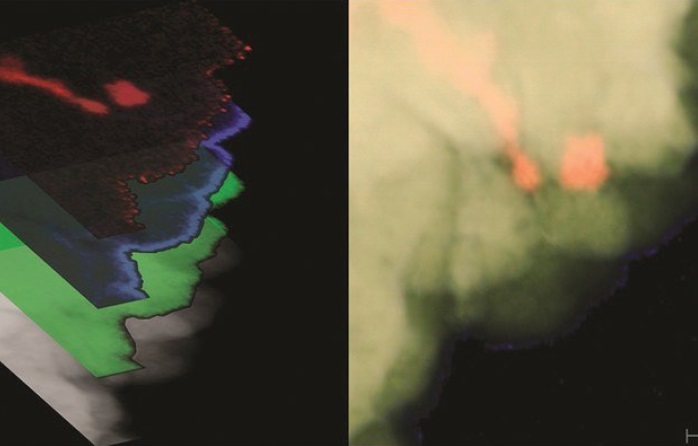Transverse thermoelectric device
Dr. Neil Canter, Contributing Editor | TLT Tech Beat March 2017
The entire composite containing platinum nanoparticles dispersed in a nickel matrix can be used to convert heat into electricity.
KEY CONCEPTS
•
A new material based on nickel and platinum is more efficient in converting heat to electricity.
•
This material boosts the transverse thermoelectric performance of magnetic nanocomposite materials by a factor of 10.
•
The advantage of transverse devices is that the entire material is used to produce electricity instead of the small volume of material near the magnetic/film interface in longitudinal devices.
THE INEFFICIENCIES FOUND in such machinery as automobile engines due to the production of heat energy is leading researchers to determine how best to convert this waste byproduct through the use of themoelectrics. As noted in a previous TLT column, thermoelectrics convert heat into electricity in the case of an automobile engine by taking advantage of the difference in temperature between the exhaust gas and the temperature of the ambient air (
1).
Researchers at Ohio State University have developed a new material made from nickel and platinum that displays a substantial enhancement in its thermally induced voltage when compared to similar reference samples of nickel alone. This enhancement is due to spin transport effects that occur inside the platinum nanoparticles, an effect that had previously been observed only when the platinum was present in the form of a high quality thin film coating the top surface of a magnetic material.
This composite takes a new approach to developing more effective thermoelectric devices: the spin Seebeck effect. Dr. Stephen Boona, postdoctoral researcher at Ohio State University in Columbus, Ohio, says, “The classic charge Seebeck effect involves the production of a voltage between the hot and cold ends of a material in the presence of a temperature gradient. Analogously, the spin Seebeck effect involves the production of a difference in magnetic properties between the hot and cold ends of a ferromagnetic material. This difference in magnetic properties creates a ‘spin voltage.’ When a ‘normal metal’ like platinum comes into contact with the ferromagnet, the electrons inside the metal feel this spin voltage and become polarized. These polarized electrons then experience a phenomenon known as the inverse spin Hall effect, which creates an electrical voltage in the metal. This electrical voltage is proportional to the spin voltage in the ferromagnet but perpendicular to the direction of heat flow.”
Further details on the inverse spin Hall effect can be found in a recent TLT column that discusses how researchers used this effect to enable organic semiconductors to produce spin current at a magnitude not seen previously (
2).
Thermoelectric devices have traditionally been built using what is known as a longitudinal geometry based on the classic charge Seebeck effect where voltage arises in the same direction as heat flow. Boona says, “Longitudinal devices have been used in niche applications for over 50 years. The performance of these devices depends on the intrinsic properties of the constituent materials—you will always get the same total voltage out from the same total temperature drop, no matter how big you make the device. In contrast to this, transverse devices involve voltages generated perpendicular to the direction of the heat flow. This spatial decoupling means that more voltage can be produced by the same temperature drop simply be elongating the device in the direction of charge flow. Energy conversion devices based on the spin Seebeck effect are transverse devices. However, such devices have so far been made only by applying thin films maybe a few atoms thick on top of a ferromagnetic material. This is fine for laboratory experiments, but it is time consuming, expensive and impractical for most applications.”
This reliance on thin films means preparation of transverse spin Seebeck-based devices is difficult due to the need for high vacuum chambers to produce high quality materials with clean interfaces. On top of that, the small cross section of the metallic thin films means they have high electrical resistance, which introduces inefficiencies when trying to draw electrical power from such devices. To make matters worse, the use of thick substrates below the films means only thermal energy very near the interface ends up being converted into electrical energy. Together, these factors lead to compounding inefficiencies that make it difficult to believe that such devices can be used commercially.
If practical devices are ever going to arise based on the spin Seebeck effect, then a new approach is needed that allows for devices to be prepared in a more cost effective manner while also showing the potential for generating higher levels of electrical power. Boona’s proof-of-concept study now provides the conceptual blueprints for how such a device might work.
COMPOSITE
Boona, in collaboration with Joseph Heremans, Ohio eminent scholar in mechanical and aerospace engineering and a professor of physics and material science & engineering at Ohio State University, has devised a way to use the spin Seebeck effect to increase the transverse thermoelectric performance of magnetic nanocomposite materials by a factor of 10. Boona says, “We looked at the traditional structures used for studying the spin Seebeck effect, and we asked, why do we have to use thin films on single-crystal substrates? These are not very practical for energy conversion. What happens if we scramble everything into a random bulk material? Is the effect still there? We thought it would be, but we had to run experiments to make sure.”
After careful consideration, Boona and his collaborators decided to test this idea by randomly dispersing platinum nanoparticles in a matrix of nickel, a conducting magnetic material. When they measured the composite’s properties, they saw an enhancement in the transverse voltage, the exact same effect previously seen only in thin film structures. By comparing this “extra” voltage with the materials’ magnetic properties, they were able to successfully explain this enhancement as originating from the spin Seebeck effect.
The researchers produced the composite by reducing salt derivatives of nickel and platinum in an aqueous environment. The nickel particles exhibit a particle size of 100 nanometers while the platinum particles are five nanometers in diameter. Figure 2 shows a transmission electron microscope image of the composite material on the right while the left shows the image overlaid with false-color maps of platinum (red), nickel (green) and oxygen (blue).
 Figure 2. A transmission electron microscope image of a composite material prepared from dispersing platinum nanoparticles in a matrix of nickel is shown on the right. The image overlaid with false-color maps of platinum (red), nickel (green) and oxygen (blue) is shown on the left. (Figure courtesy of Ohio State University.)
Figure 2. A transmission electron microscope image of a composite material prepared from dispersing platinum nanoparticles in a matrix of nickel is shown on the right. The image overlaid with false-color maps of platinum (red), nickel (green) and oxygen (blue) is shown on the left. (Figure courtesy of Ohio State University.)
Boona says, “We decided to use nickel because this metal is easy to work with and relatively cheap. Platinum is a standard material that has been widely used in spin Seebeck experiments for a number of reasons, and it also happens to work well in nanoparticle form, so it was a convenient choice for demonstration purposes.”
One minor problem seen by the researchers is the formation of nickel oxide, an antiferromagnetic material that inhibits charge transport between the nickel and platinum particles. Boona says, “We believe that nickel oxide is formed immediately during the co-precipitation process used to prepare the nickel and platinum composite. We have not yet examined the effect of this oxide layer in greater detail, so we do not know whether it helps or hurts the thermoelectric properties overall.”
The anticipated formation of this oxide layer is another reason nickel was chosen for this demonstration project since it typically forms only one oxide phase. Other magnetic metals that could be used (such as cobalt and iron) are capable of forming multiple oxides with a variety of properties, which would have complicated efforts to interpret the researchers’ observations.
While this initial composite only displayed a small performance advantage compared to nickel nanoparticles used as a control, the key result is that the idea works. Boona says, “With a bulk composite, the entire material can be used to produce electricity instead of relying on only the small volume of material near the magnet/film interface. In these nanocomposites, there are billions of tiny interfaces distributed throughout the entire sample volume.”
One of the reasons for optimism is that the wet chemistry and powder processing techniques used to prepare the composite can be scaled up at a low cost. To emphasize the importance of scalability, Boona concludes by citing a quote from Heremans that “generating kilowatts of power from thermoelectric devices generally requires using kilograms of thermoelectric material. This is unimaginable with thin films but entirely plausible with bulk composites.”
Additional information can be found in a recent article (
3) or by contacting Boona at
boona.1@osu.edu.
REFERENCES
1.
Canter, N. (2015), “High power-factor thermoelectric material,” TLT,
71 (7), pp. 12-13.
2.
Canter, N. (2016), “Potential new energy source: ‘Inverse spin hall effect,’” TLT,
72 (7), pp. 10-11.
3.
Boona, S., Vandaele, K., Boona, I., McComb, D. and Heremans, J. (2016), “Observation of spin Seebeck contribution to the transverse thermopower in Ni-Pt and MnBi-Au bulk nanocomposites,”
Nature Communications, Article Number: 13714.
 Neil Canter heads his own consulting company, Chemical Solutions, in Willow Grove, Pa. Ideas for Tech Beat can be submitted to him at neilcanter@comcast.net
Neil Canter heads his own consulting company, Chemical Solutions, in Willow Grove, Pa. Ideas for Tech Beat can be submitted to him at neilcanter@comcast.net.